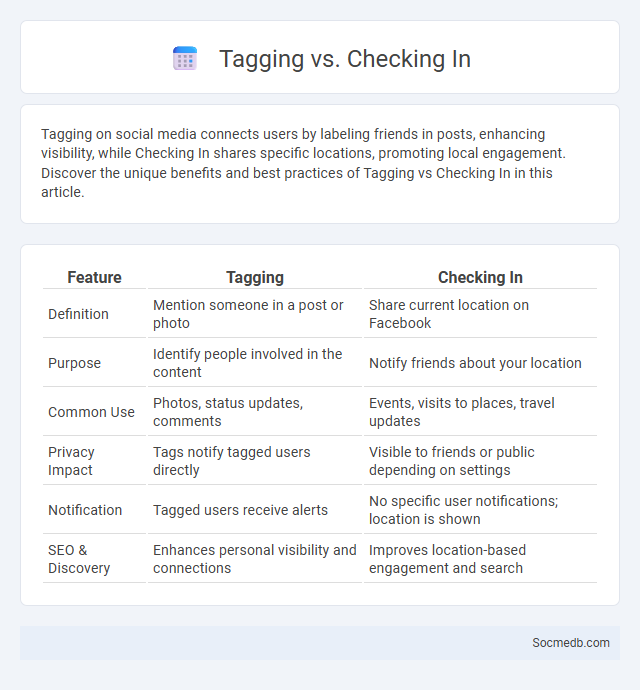
Photo illustration: Tagging vs Checking In
Tagging on social media connects users by labeling friends in posts, enhancing visibility, while Checking In shares specific locations, promoting local engagement. Discover the unique benefits and best practices of Tagging vs Checking In in this article.
Table of Comparison
| Feature | Tagging | Checking In |
|---|---|---|
| Definition | Mention someone in a post or photo | Share current location on Facebook |
| Purpose | Identify people involved in the content | Notify friends about your location |
| Common Use | Photos, status updates, comments | Events, visits to places, travel updates |
| Privacy Impact | Tags notify tagged users directly | Visible to friends or public depending on settings |
| Notification | Tagged users receive alerts | No specific user notifications; location is shown |
| SEO & Discovery | Enhances personal visibility and connections | Improves location-based engagement and search |
Understanding Tagging: Definition and Purpose
Tagging on social media involves labeling individuals, brands, or topics within posts to enhance visibility and engagement. It serves the purpose of connecting content to relevant users or categories, thereby increasing reach and fostering interaction. Effective tagging improves content discoverability and helps build targeted online communities.
What Does Checking In Mean? An Overview
Checking in on social media means sharing your current location or activity with your followers, often through platforms like Facebook, Instagram, or Snapchat. Your check-in can include tags of specific places, events, or businesses, enhancing social visibility and engagement while allowing friends to see where you are. This feature helps you connect with your network by providing real-time updates and creating social interactions based on location.
Tagging vs Checking In: Key Differences
Tagging on social media involves identifying and linking friends or relevant accounts in posts, photos, or comments to increase engagement and visibility, while checking in specifically denotes sharing a location at a certain place or event. Tagging helps boost social interactions by connecting content directly to people's profiles, enhancing network reach and personalized engagement. Checking in primarily serves location-based context, providing real-time updates and local discovery, which can drive foot traffic and promote businesses or events more effectively.
How Tagging Enhances Social Media Engagement
Tagging on social media boosts engagement by increasing visibility and fostering connections among users. When you tag friends, influencers, or brands, your content reaches broader audiences, inviting more likes, comments, and shares. This targeted interaction enhances your online presence and builds a loyal community around your posts.
The Benefits of Checking In on Social Platforms
Checking in on social media platforms enhances user engagement by increasing visibility and fostering community interaction. Businesses benefit from these location tags by gaining valuable insights into customer behavior and boosting local brand awareness. Frequent check-ins contribute to organic reach growth, driving foot traffic and strengthening social proof for both individuals and companies.
Tagging Etiquette: Best Practices for Users
Proper tagging etiquette on social media enhances engagement while respecting privacy and consent, ensuring users only tag relevant individuals with permission. Utilize accurate and clear tags to maintain content relevance and avoid spammy behavior that can diminish user experience. Following platform-specific guidelines and considering audience sensitivity promotes a positive online environment and strengthens social connections.
Privacy Implications: Tagging vs Checking In
Tagging on social media exposes users to identity and location privacy risks by linking them directly to specific posts and photos, often without explicit consent. Checking in shares precise geographic data and time stamps, making users vulnerable to real-time tracking and potential security threats. Both practices increase data visibility, emphasizing the need for robust privacy settings and user awareness.
Which Is Better for Businesses: Tagging or Checking In?
Tagging customers or locations in social media posts enhances brand visibility and fosters community engagement by directly linking your business to relevant audiences. Checking in allows Your audience to share their presence at your physical location, building social proof and encouraging local customer interaction. Choosing between tagging and checking in depends on your marketing goals, with tagging driving broader online reach and checking in boosting local foot traffic and trust.
Common Misconceptions About Tagging and Checking In
Tagging on social media is often misunderstood as a feature solely for identifying people, but it also enhances content discoverability and engagement by associating posts with relevant entities. Checking in is commonly mistaken for just sharing location, whereas it also serves marketing purposes by promoting venues and events to a wider audience. Misconceptions about privacy concerns frequently deter users from utilizing these features, despite platform settings that allow control over visibility and audience.
Choosing the Right Feature: When to Tag or Check In
Choosing the right feature for your social media posts enhances engagement by targeting your audience effectively. Tagging friends or brands boosts visibility and fosters community interaction, while checking in pinpoints your location, adding authenticity to your content. Understanding when to tag or check in allows you to maximize reach and create meaningful connections with Your followers.
 socmedb.com
socmedb.com